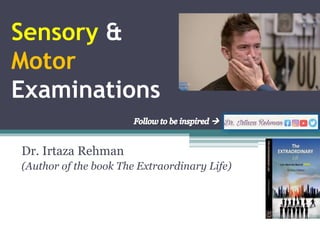
Sensory & Motor Examinations.pptx
- 1. Sensory & Motor Examinations Dr. Irtaza Rehman (Author of the book The Extraordinary Life)
- 3. Learning Objectives • What is the lesion? • Where is the lesion? • Why has the lesion occurred?
- 4. Neurological Examination • Mental Status • Speech • Cranial nerves • Motor Examination • Sensory Examination
- 7. Motor System
- 8. Motor Examination • Stance & Gait • Inspection & palpation • Tone • Power • Reflexes • Coordination
- 9. Stance • Ask the patient to stand with their (preferably bare) feet close together and eyes open. • Swaying, lurching or an inability to stand with the feet together and eyes open suggests cerebellar ataxia • Romberg sign: When the patient is unable to maintain the balance with their eyes closed. Dorsal column lesion.
- 10. • Always get ready to catch them if they fall. Stance
- 11. Gait • Time the patient walking a measured 10 meters, then turning through 180 degrees and returning. • Note stride length, arm swinging, steadiness (turning), limping or other difficulties. • Ask the patient to walk heel to toe in a straight line (Tandem gait). Abnormal in cerebellar lesions.
- 12. Gait Tandem Gait
- 17. Inspection & Palpation • Completely expose the muscle to be examined • Look for asymmetry, inspecting both proximally and distally. • Inspect for wasting or hypertrophy, fasciculation and involuntary movement.
- 18. Muscle Bulk
- 19. Fasciculation • Spontaneous, involuntary muscle contraction and relaxation. • Visible irregular twitches of resting muscle. • Lower motor neuron lesion
- 20. Abnormal movements • Myoclonic jerks: Sudden shock like contraction of one or more muscle, singly or repetitively. (Hypnic jerks in sleep). • Tremors: Essential tremors, Intentional tremors, Pill rolling tremors. • Chorea, Athetosis, Hemiballismus
- 21. Inspection • Scars • Wasting of muscles • Involuntary movements • Fasciculations • Tremors SWIFT
- 22. Tone • Resistance felt by the examiner when moving a joint. • Passively move each joint to be tested through as full range possible • Distract the patient for fully passive assesment • Hypotonia (LMN) – Hypertonia (UMN)
- 23. Tone Clasp Knife Spasticity Lead pipe rigidity UMN Lesion Parkinsons
- 24. Clonus • Rhythmic series of contraction evoked by sudden stretch of the muscle and tendon. • UMN lesion
- 25. Power • Strength varies with age, occupation and fitness. • Observe the patient getting up from a chair and walking • Test upper limb power while patient sitting on the edge of the couch. Test lower limb with patient lying supine. • Ask patient to lift their arms above their heads
- 26. Power • MRC grading • 0 No muscle contraction • 1 Flicker or trace of contraction but no movement • 2 Active movement, with gravity eliminated • 3 Active movement against gravity • 4 Active movement against gravity and resistance • 5 Normal power
- 27. Power
- 28. Power Shoulder adduction Shoulder abduction
- 29. Power Elbow flexion Elbow extension
- 30. Power Wrist extension Wrist flexion
- 31. Power Fingers extension Fingers flexion
- 32. Power Fingers abduction Thumb adduction
- 33. Sensory System • Light touch • Pain • Temperature • Vibration • Proprioception • Two point discrimination • Stereognosis (tactile recognition) • Graphaesthesia (identification of letters/numbers traced on skin)
- 34. Sensory system • A dermatome is an area of skin that is mainly supplied by a single spinal nerve
- 39. Jazakumullahu Khair ♥ (May ALLAH swt reward you with goodness)
